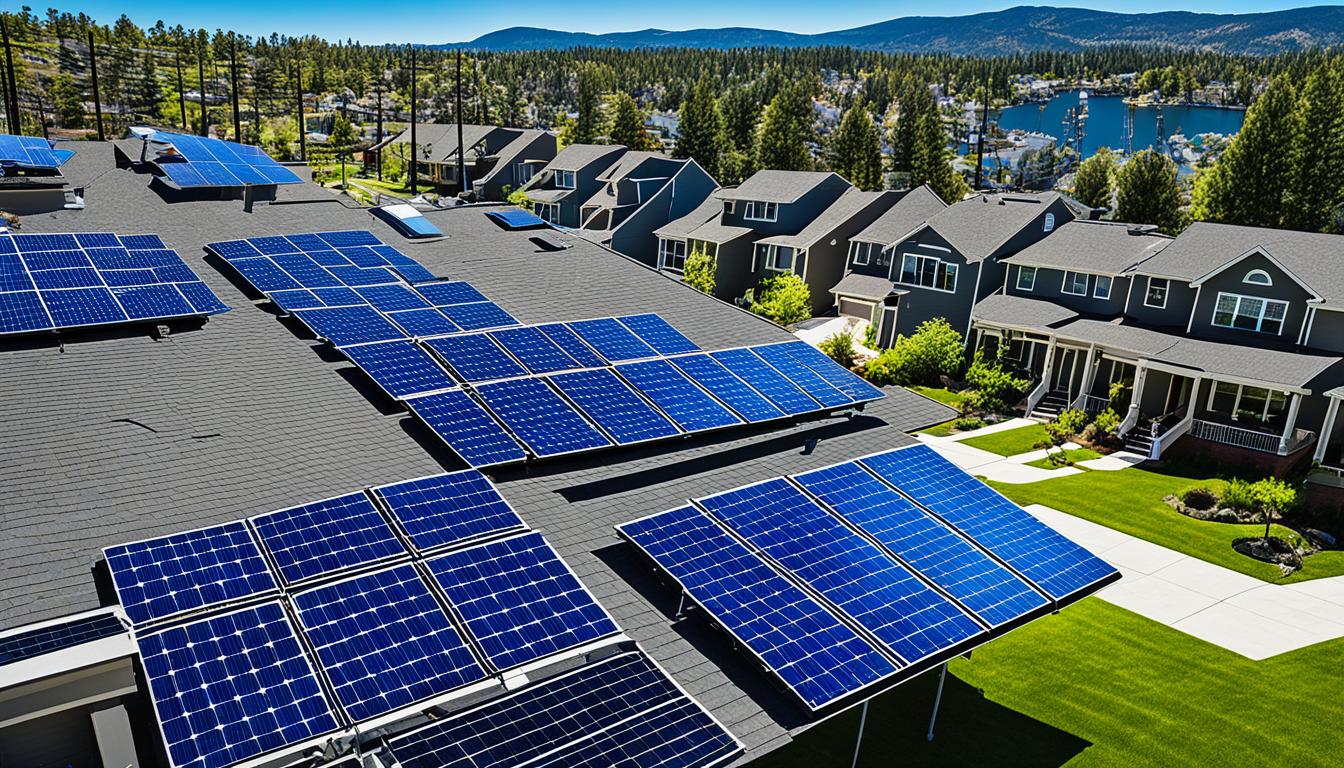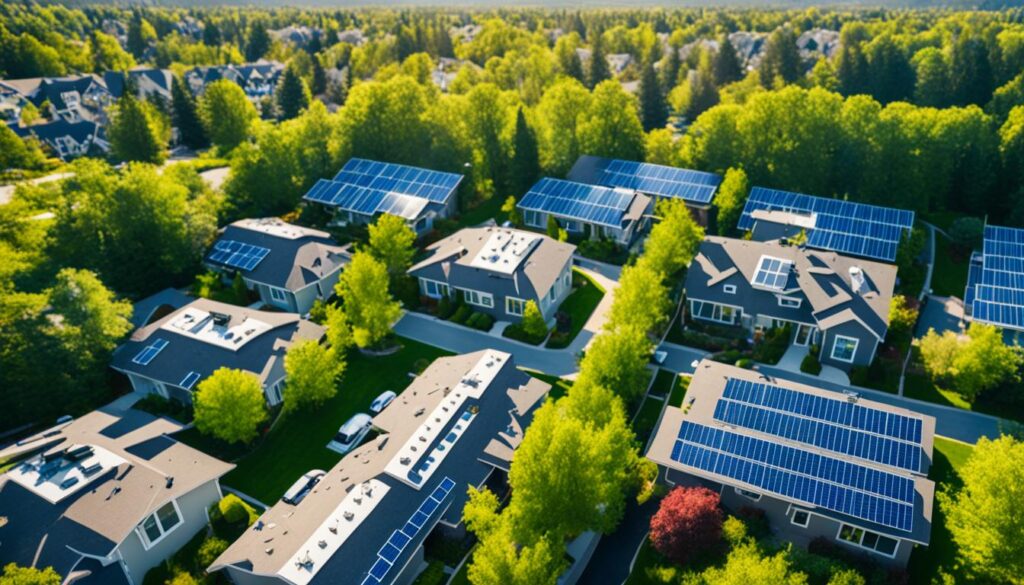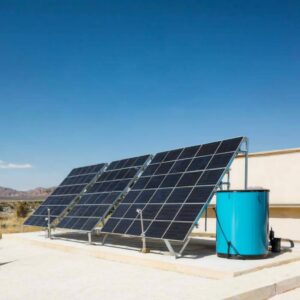
As the demand for renewable energy continues to grow, homeowners and businesses are increasingly looking for ways to profit from their solar energy systems. One lucrative opportunity is selling excess solar energy back to the grid. By connecting their solar panels to the local power grid and feeding excess energy into it, individuals and organizations can earn credits or cash for the electricity they generate. This article will explore the steps and benefits of selling solar energy back to the grid.
Key Takeaways:
- Connect your solar energy system to the grid to sell excess energy.
- Earn credits or cash for the electricity you generate.
- Maximize the financial return on your solar investment.
- Support the growth of renewable energy.
- Take advantage of financial incentives offered by utility companies.
How to Connect Your Solar Energy System to the Grid
Connecting your solar energy system to the grid involves several important steps. By following these steps, you can ensure that your system is properly connected and optimized for selling solar energy back to the grid.
- Ensure Technical Requirements and Safety Standards: Before connecting your solar energy system to the grid, it is crucial to ensure that it meets all the necessary technical requirements and safety standards. This may involve obtaining permits and scheduling inspections to ensure compliance.
- Work with a Licensed Electrician: To ensure a safe and efficient connection, it is highly recommended to work with a licensed electrician who specializes in solar energy system installations. They will have the expertise and knowledge to properly install the necessary equipment and wiring for connecting your system to the grid.
- Install a Bi-Directional Meter: A bi-directional meter is an essential component when connecting your solar energy system to the grid. This meter can measure both the energy you consume from the grid and the excess energy you feed into it. It allows for accurate measurements and facilitates the process of crediting or selling the excess energy generated by your solar panels.
- Establish a Net Metering Agreement: In order to sell your solar energy back to the grid, you will need to establish a net metering agreement with your utility company. This agreement outlines the terms and conditions for selling energy back to the grid and ensures a fair and transparent process.
By completing these steps, you can connect your solar energy system to the grid and start taking advantage of the benefits of selling solar energy back to the grid.
Case Study: Successful Grid Connection
Let’s take a look at the successful grid connection of a residential solar energy system owned by Mr. Johnson.
| Step | Description | Status |
|---|---|---|
| 1 | Ensuring Technical Requirements and Safety Standards | Completed |
| 2 | Working with a Licensed Electrician | Completed |
| 3 | Installing a Bi-Directional Meter | Completed |
| 4 | Establishing a Net Metering Agreement | Completed |
Mr. Johnson successfully connected his solar energy system to the grid by completing all the necessary steps. He can now enjoy the benefits of selling his excess solar energy back to the grid, reducing his energy costs, and making a positive impact on the environment.
“Connecting my solar energy system to the grid was a smooth process with the help of a licensed electrician. Now, I can see the energy credits accumulating on my bi-directional meter, which is incredibly rewarding.”
Now that you understand the connection process, let’s explore the benefits of selling solar energy back to the grid in the next section.
The Benefits of Selling Solar Energy to the Grid
There are numerous benefits to selling solar energy back to the grid. First and foremost, it allows you to maximize the financial return on your solar investment. By earning credits or cash for the excess energy you generate, you can offset your electricity bills and potentially even make a profit.
Additionally, selling solar energy back to the grid supports the growth of renewable energy and contributes to a more sustainable future. By participating in this process, you play a vital role in reducing reliance on fossil fuels and combating climate change. This is a significant benefit that aligns with the increasing global focus on transitioning to clean energy sources.
Furthermore, many utility companies offer financial incentives to encourage the uptake of solar energy. These incentives may include feed-in tariffs or performance-based incentives. For example, some utility companies provide a feed-in tariff where you are paid a fixed rate for every kilowatt-hour of solar energy you feed back into the grid. Alternatively, performance-based incentives reward you based on the actual amount of energy you generate. These financial incentives not only enhance the overall benefits of selling solar energy back to the grid but also accelerate the return on your investment.
To summarize, selling solar energy back to the grid offers a range of benefits, including financial returns, support for renewable energy growth, and access to financial incentives. It is a win-win situation where individuals and organizations can make a positive impact on the environment while also reaping the financial rewards of their solar investment.

| Benefits | Explanation |
|---|---|
| Maximizing Financial Return | Earn credits or cash to offset electricity bills and potentially make a profit. |
| Supporting Renewable Energy | Contribute to a more sustainable future by reducing reliance on fossil fuels. |
| Financial Incentives | Utility companies offer incentives such as feed-in tariffs or performance-based incentives. |
Conclusion
Selling solar energy back to the grid is a brilliant opportunity for homeowners and businesses to profit from their solar energy systems. By connecting their solar panels to the local power grid and feeding excess energy into it, individuals and organizations can earn credits or cash for the electricity they generate. This process involves connecting the solar energy system to the grid, obtaining the necessary permits and inspections, installing a bi-directional meter, and establishing a net metering agreement.
The benefits of selling solar energy to the grid are substantial. Not only does it enable individuals and businesses to maximize the financial return on their solar investments, but it also contributes to the growth of renewable energy and promotes a more sustainable future. Additionally, many utility companies provide financial incentives such as feed-in tariffs or performance-based incentives, further enhancing the financial rewards of selling solar energy back to the grid.
In summary, selling solar energy back to the grid offers a win-win scenario for both the environment and the pocket. It allows individuals and organizations to make a positive impact by harnessing renewable energy while also earning a profit. So if you’re considering investing in solar energy, don’t miss out on the opportunity to sell your excess energy back to the grid and reap the financial benefits in addition to contributing to a greener future.
FAQ
How does selling solar energy back to the grid work?
When you connect your solar energy system to the local power grid, any excess energy that your system generates can be fed back into the grid. This excess energy is then credited to your account, either in the form of credits on your electricity bill or direct cash payments from your utility company.
What are the technical requirements and safety standards for connecting a solar energy system to the grid?
Before connecting your solar energy system to the grid, you will need to ensure that it meets all the necessary technical requirements and safety standards. This may involve obtaining permits and inspections to ensure that your system is safe and compliant with local regulations.
How do I install a bi-directional meter to measure the energy I consume and the excess energy I feed into the grid?
To measure the energy you consume from the grid and the excess energy you feed into it, you will need to work with a licensed electrician to install a bi-directional meter. This meter is capable of measuring the flow of electricity in both directions and accurately recording the energy consumption and generation.
What is a net metering agreement and how do I establish one?
A net metering agreement is a contract between you and your utility company that outlines the terms and conditions for selling energy back to the grid. It specifies how the excess energy will be credited or compensated. To establish a net metering agreement, you will need to contact your utility company and provide them with the necessary documentation and information about your solar energy system.
How can selling solar energy back to the grid maximize my financial return?
Selling solar energy back to the grid allows you to earn credits or cash for the excess energy you generate. By offsetting your electricity bills with these credits and potentially even making a profit, you can maximize the financial return on your solar investment.
What are the environmental benefits of selling solar energy back to the grid?
Selling solar energy back to the grid supports the growth of renewable energy and contributes to a more sustainable future. By feeding excess solar energy into the grid, you are reducing the reliance on fossil fuels and helping to reduce greenhouse gas emissions.
Do utility companies offer financial incentives for selling solar energy back to the grid?
Yes, many utility companies offer financial incentives to encourage the uptake of solar energy. These incentives can include feed-in tariffs, where you are paid a premium for the solar energy you generate, or performance-based incentives that reward you based on the amount of energy you produce. These financial incentives can further boost the financial benefits of selling solar energy back to the grid.
Source Links
- https://www.share-talk.com/sp-angel-morning-view-todays-market-view-friday-1st-march-february-2023/
- https://ca.investing.com/news/stock-market-news/earnings-call-marathon-digital-posts-record-bitcoin-production-in-2023-93CH-3285123
- https://www.dsij.in/dsijarticledetail/artmid/10163/articleid/36886/rs-50000-crore-order-book-lic-backed-multibagger-penny-stock-bags-multiple-new-orders-worth-rs-609-crore-do-you-hold-it-36886








